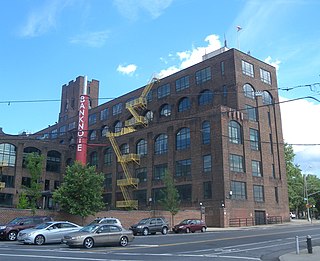Murder, Inc. was an organized crime group active from 1929 to 1941 that acted as the enforcement arm of the National Crime Syndicate – a closely connected criminal organization that included and was started by the Irish Mob, and included Italian-American Mafia, the Jewish Mob, and other criminal organizations in New York City and elsewhere. Murder, Inc. was composed of Irish, Jewish, and Italian-American gangsters, and members were mainly recruited from poor and working-class Irish, Jewish, and Italian neighborhoods in Manhattan and Brooklyn. It was initially headed by Louis "Lepke" Buchalter and later by Albert "Mad Hatter" Anastasia.

Dutch Schultz was an American mobster based in New York City in the 1920s and 1930s. He made his fortune in organized crime-related activities, including bootlegging and the numbers racket. Schultz's rackets were weakened by two tax evasion trials led by United States Attorney Thomas Dewey, and also threatened by fellow mobster Lucky Luciano.

Hunts Point is a neighborhood located on a peninsula in the South Bronx of New York City. It is the location of one of the largest food distribution facilities in the world, the Hunts Point Cooperative Market. Its boundaries are the Bruckner Expressway to the west and north, the Bronx River to the east, and the East River to the south. Hunts Point Avenue is the primary street through Hunts Point.

Longwood is a mixed-use neighborhood in the southeast Bronx in New York City. Its boundaries, starting from the north and moving clockwise are East 167th Street to the north, the Bronx River and the Bruckner Expressway to east, East 149th Street to the south, and Saint Anns Avenue to the west. Southern Boulevard is the primary thoroughfare through Longwood.

Soundview is a neighborhood on the Clason Point peninsula, on the southern section of the borough of the Bronx in New York City. Its boundaries, starting from the north and moving clockwise, are the Cross-Bronx Expressway to the north, White Plains Road to the east, Lacombe Avenue to the south, and the Bronx River to the west. The Bruckner Expressway bisects the neighborhood horizontally along the center and the Bronx River Parkway runs north to south. Soundview Avenue is the primary thoroughfare through Soundview.

Hart Island, sometimes referred to as Hart's Island, is located at the western end of Long Island Sound, in the northeastern Bronx in New York City. Measuring approximately 1 mile (1.6 km) long by 0.33 miles (0.53 km) wide, Hart Island is part of the Pelham Islands archipelago and is east of City Island.

Morton Sobell was an American engineer and Soviet spy during and after World War II; he was charged as part of a conspiracy which included Julius Rosenberg and his wife, Ethel Rosenberg. Sobell worked on military and government contracts with General Electric and Reeves Instrument Corporation in the 1940s, including during World War II. Sobell was tried and convicted of espionage in 1951 and sentenced to 30 years in prison.
Peter Anthony Quinn of New York City was a Democratic U.S. Representative from New York from 1945 to 1947. Quinn was a justice of the New York Supreme Court from 1955 to 1974.
Louis Robert Gigante was an American priest of the Catholic Church and a Bronx community activist, serving as one of the borough's New York City Council members. He founded the South East Bronx Community Organization (SEBCO).

Robert Lawrence Moran, was a Bronx politician who served as president of the Board of Aldermen of New York City from 1918 to 1920, filling a vacancy after Alfred E. Smith was elected Governor of New York. Nominated by the Democratic Party to succeed himself as board president, Moran faced Republican Representative Fiorello H. La Guardia in the election of 1919, losing by a plurality of 1,363 votes. Moran has the distinction of being the only citizen of The Bronx to ever exercise the authority of mayor of New York City, even though this honor came to him only in his capacity as acting mayor during Mayor Hylan's absences from the city.
Myron A. Farber is an American newspaper reporter for The New York Times, whose investigations into the deaths of several patients at an Oradell, New Jersey, hospital led to the murder trial of Mario Jascalevich, a physician at the hospital who was alleged to have used a powerful muscle relaxant in what became known as the "Dr. X" case. After refusing to turn over notes from his investigation in response to a subpoena from the defense attorney in the case, Farber was jailed for contempt and the newspaper fined, ending up spending 40 days in jail with fines of $285,000 assessed. Appealed to the Supreme Court of the United States, the case set a precedent for the limitations of shield laws in the United States.
Manhattan General Hospital is a defunct hospital that also used the name Manhattan Hospital and relocated more than once, using buildings that serially served more than one hospital, beginning in the 1920s.

Alva Erskine Belmont, known as Alva Vanderbilt from 1875 to 1896, was an American multi-millionaire socialite and women's suffrage activist. She was noted for her energy, intelligence, strong opinions, and willingness to challenge convention.
Saugus General Hospital was a hospital located in Saugus, Massachusetts. At the time of its closure, Saugus General Hospital was a 109-bed facility with surgical facilities, x-ray rooms, a laboratory, a pharmacy, and a cafeteria located in two interconnected buildings.
The following is a timeline of the history of the borough of the Bronx in New York City, New York, United States.

The American Bank Note Company Printing Plant is a repurposed printing plant in the Hunts Point neighborhood of the Bronx in New York City. The main structure includes three interconnected buildings. The Lafayette wing, spanning the south side of the block, is the longest and tallest, incorporating an entrance at the base of a nine-story tower. The lower, more massive Garrison wing is perpendicular. These two were built first, and constitute the bulk of the complex. Prior to the American Bank Note Company purchasing the property, the land on which the printing plant was built had been part of Edward G. Faile's estate.

The James J. Peters VA Medical Center,, is a US Department of Veterans Affairs hospital complex located at 130 West Kingsbridge Road in West Fordham, Bronx, New York City. The hospital is the headquarters of the Veterans Integrated Service Networks New York/New Jersey VA Health Care Network. This network is also the parent network to VA New York Harbor Healthcare System.
Edward George Faile was an American merchant. Born in Scotland, his family moved to the United States when he was an infant, settling in Westchester County, north of New York City. The family initially lived in East Chester, and later moved closer to New York City, building a family estate in what is now the Hunts Point section of The Bronx. The location of the Faile mansion, Woodside, became the site of the American Bank Note Company Printing Plant. Faile ran a successful grocery business in Lower Manhattan from 1821 to 1853. He was also involved in the railroad, insurance, and agriculture industries.

The New Jewish Home is an American nonprofit older adult health care system based in New York City. The organization serves older adults of all religions and ethnicities at its three campuses in Manhattan, The Bronx, and Mamaroneck in Westchester County. It provides rehabilitative services, skilled nursing, senior housing, and numerous home health programs, including a certified home health agency and a home care agency. The organization was founded in 1848 by Hannah Leo of the B'nai Jeshurun Ladies' Benevolent Society.











